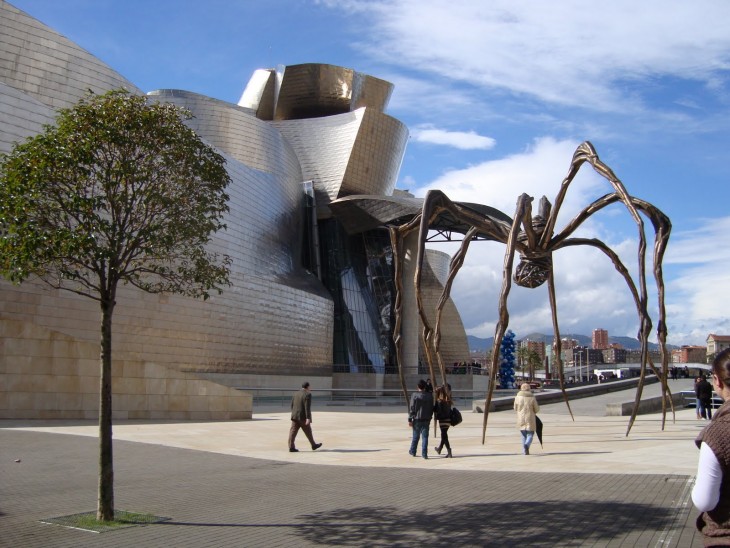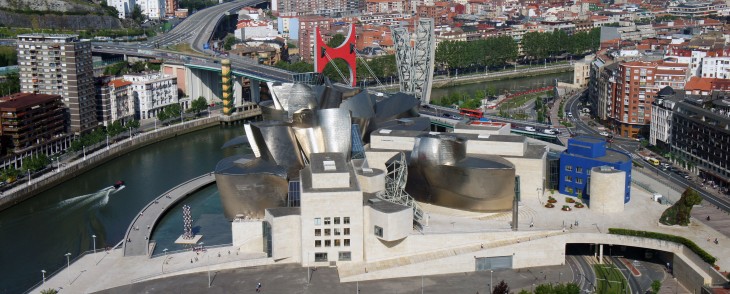
When you first read the title of this essay , the first thing that will come to your mind is that this paper will be an architectural description of a “ famous “ building done by a “ famous “ star architect Frank Gehry . In fact , I’ve been doing much studies and research on the circumstances behind the construction of this building ,trying to figure out if that building was constructed in Bilbao only for it’s architectural beauty .This text won’t be discussing the architectural aspects and characteristics of such a huge project instead I will be discussing the reasons behind building such a museum , using the most expensive metallic material and locating it next to the river . I will be discussing also the relationship between architecture , economy and society through Guggenheim museum and how architecture could be a perfect response to economic difficulties in cities .
Let us first go back to the history of the construction of this building : Guggenheim museum was first open to public in 1997 . The real story begins in 1991 when the director of the Solomon R Guggenheim foundation Thomas Krenz was looking for a new museum site in Europe and at that time the American foundation had several all over the world : the best known being the one in New York designed by Frank Lloyd Wright .
Going back to Spain , the president of the autonomous basque region invited Thomas to Bilbao : and It’s here , for me , where we can start understanding the project : why they chose Bilbao not Barcelona or Madrid or … ?
Understanding why Bilbao was selected that time , the analysis took us back to the year 1991 trying to create an image on the situation of the city back then . Remarkably , the city was suffering due to huge economic problems : its factories and shipyards were closing one after the other , the city was facing a huge economic crisis , unemployment indicator was at it’s highest and the city “ engines “ were nearly stopping .
But is it possible to build such a huge museum in such situations ? it was for sure an unlikely setting for such a masterpiece . A quick question came to my mind : why taking the risk and building a fabulous building where no one is visiting ? and then I started thinking if this economic crisis was the main reason behind taking such a difficult decision and if this architecture by its implementation could really help the city to breathe back again .
After reading the stupid legend the people say about Guggenheim museum construction : it was while he was jogging across the bridge on his run through the city , Thomas had a revelation that the museum should be on that industrial wasteland in the “middle of the city “ and on the “ banks of the river “ : thinking about this story as a simple revelation for a normal person to implement such a building in such a place is also stupid , this makes me reinforce my idea that the economic situation was the main motivator , guide and controller of every architectural urban thinking in this project .
Choosing the middle of the city wasn’t just a simple decision of a person , choosing it to be next to the river banks isn’t also another simple decision taken by Guggenheim foundation director . As we know , the river is one of the main transportation methods used by millions of people all around Europe and mostly by tourist crossing all around cities and taking advantage of it . The middle of the city , is the heart of the city , and this heart can make all its periphery concerned and participating . So in order to “ reanimate “ the city you will have to start by its heart , not to forget the strategic situation in the middle of the city considering the perception of such an international museum that will force anyone to cross the whole city finding your way there .
A very important point also has to be mentioned , this point will also help me to push my idea further , as we all know that Guggenheim is an international foundation that has more than one or two or even five projects and museums all over the world . If we suppose the museums are a normal product that we can buy from supermarket , I think that this product managed to prove its place in the market as one of the leading museum foundations that hundreds of thousands of people gave their approval after visiting it all over the world . So in conclusion , choosing a well known foundation which had well tested material many years before Bilbao museum ( New York Guggenheim museum success ) was the most important key point to move on with such a critical decision . Choosing a product that people trusted through years and followed everywhere in the world was very successful for a city missing its touristic resources , missing identity related attractions and would prefer to start with an international attraction such as Guggenheim museum and benefit from its success to push tourists to visit the city of Bilbao through their decision to visit Guggenheim museum itself .
Moving back to the project itself , to its urban implementation , the object was to have a building with strong identity : it was supposed to be an object that is well identified in the city . It was supposed to make the inhabitants take their city back and change the economic identity of the years before ( industrial identity ) and struggle to stay in the city not leaving it like the generations before . They needed to have a monument to be proud of , a monument that tourists would come and stay in Bilbao to visit it . A monument that will put Bilbao on the international cultural map back again , and will force the citizens to turn their backs on the industrial period . The urban implementation of the project was also reinforcing the idea of having a cultural pole in Bilbao and eliminating its industrial image by choosing an old industrial wasteland located not only in the middle of the city and next to the river but also in the center of an already existing cultural triangle where we can find the university , the opera house and the Venice museum .
For me , it’s a real change in the identity of a city , change in the main economic source , from industry to the economy of tourism , the economy of monumentality in the city , the economy of touristic facilities . This project was really considered the fruit of this change , the result of that decision taken by the authorities for a different vision towards the city .
Moving back to more architectural characteristics concerning the decisions on how to build this museum , how an architecture can really respond to an economic decision , how can such a decision lead and control architectural decisions ?
First , starting by the selection of Frank Gehry as the leading architect for the project , Gehry was already celebrated for his strange deconstructed shapes , for the museum of Bilbao he will build a monumental sculpture to match the scale of his ambition . The selection of Gehry was also guided by the need to build a monumental “ strange “ but at the same time “ attractive “ , “ sexy “ monument that could be seen miles away from the city . Gehry was known for his strange forms , forms that created many discussions , opinions and confusion for the people but none of them can reject the idea of the majesty and monumentality of his projects . For me , this selection was really guided by a very strict decision , Gehry was chosen according to his “ different “ “ distinctive “ buildings , and this selection proved its success later .
In addition to that, this building wasn’t only a cultural monument , it was also an architectural monument considering the difficulties and challenges that faced the engineers and architects building it was considered a complete innovation in the architectural field , an innovation that worth travelling all the way to see it and understand the methods of its assembly , adopting these sexy and hard to deal with curves , this building itself had many attraction aspects and wasn’t limited on cultural or artistic attraction .
The last architectural characteristic I would like to talk about , was the selection of the skin material which was the Titanium ( one of the most expensive metallic material could be found ) .
Applying a scheme comprising more than 24 000 square meters of metal plates : the repetition of sheets folded and slightly bowed ( considered at that time a huge innovation in the world of prefabricated elements ).The use of Titanium was not only for its high cost or its technical or climatic advantages , the true reason behind the decision of Gehry to choose such a material was its specific and “ special “ ability to shine in a marvelous way when natural light hits its surfaces ( the effect can be seen mostly at the sun set ).Gehry once said that he spent days understanding the light in Bilbao and he changed the type of the metal many times to get the effect he wanted . Imagining the museum shining in the middle of the city would give this building an ability to be exposed all over the city and could be seen miles away from every corner , giving it the monumentality that this building is seeking . This expensive selection of titanium was to solidify the idea of choosing the cultural line as a future base of the city economic source . It came to mark the transition from an economic identity in Bilbao to another .
Guggenheim museum is more than a building , more than a normal museum . Guggenheim is a “ change “ monument in Bilbao . Dialog between architecture and economic situation in a city was amazingly executed even if some of us weren’t convinced with such architectural disciplines and shapes . The museum itself turned out to be the object exposed in Bilbao , where the city is the museum building and Guggenheim museum is the object to be seen : the streets of Bilbao are the corridors of a normal museum and all the shops , places , plazas of the city are the sub spaces existing in that museum .
Beyond architectural forms is a project of IaaC , Institute for Advanced Architecture of Catalonia , developed at Master in advanced architecture in 2015-2016 by :
Student :
Michel alAzzi
Faculty :
Gonzalo Delacamara

Panoramic view of the Guggenheim Museum, Bilbao, Spain